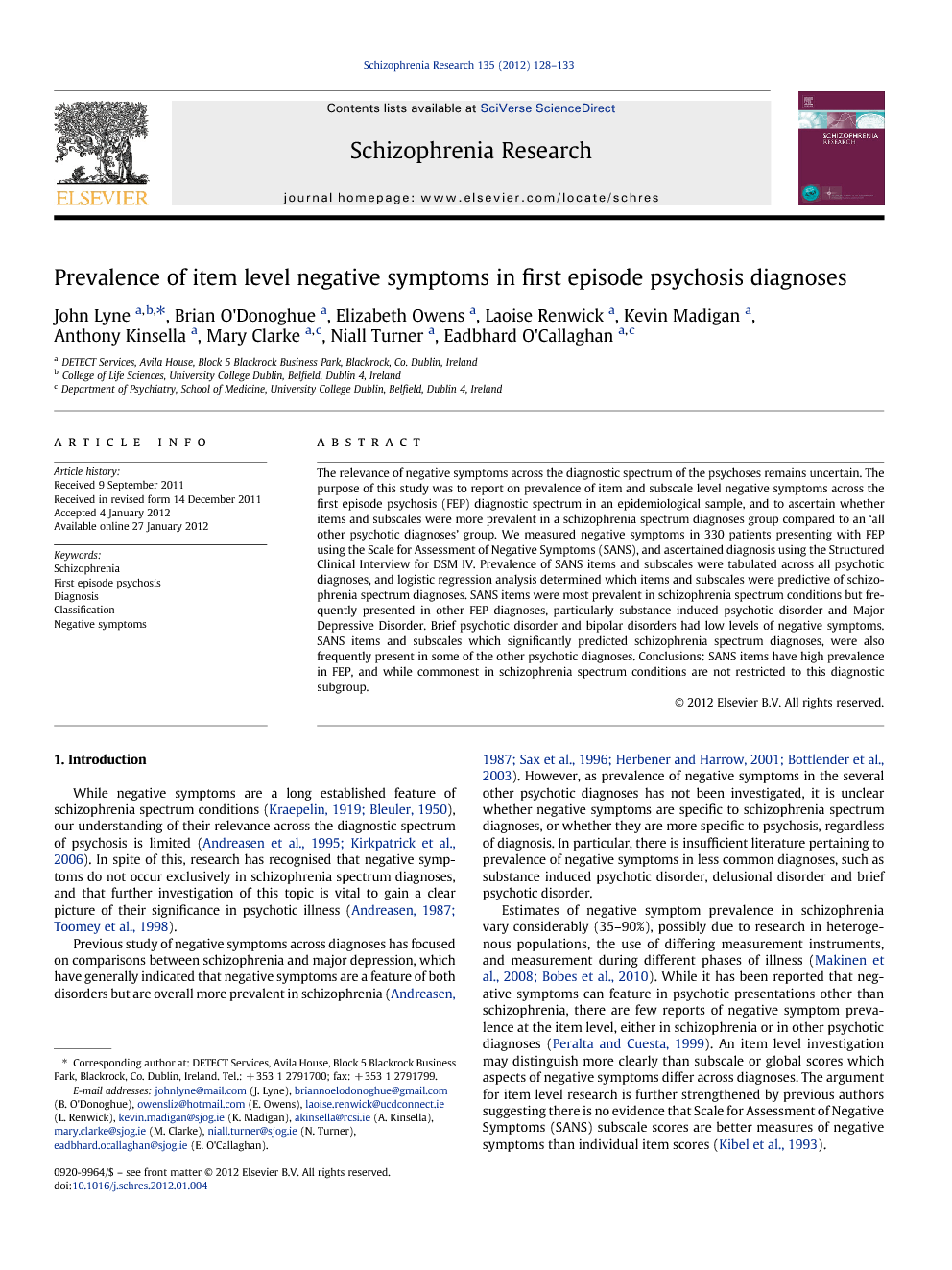The relevance of negative symptoms across the diagnostic spectrum of the psychoses remains uncertain. The purpose of this study was to report on prevalence of item and subscale level negative symptoms across the first episode psychosis (FEP) diagnostic spectrum in an epidemiological sample, and to ascertain whether items and subscales were more prevalent in a schizophrenia spectrum diagnoses group compared to an ‘all other psychotic diagnoses’ group. We measured negative symptoms in 330 patients presenting with FEP using the Scale for Assessment of Negative Symptoms (SANS), and ascertained diagnosis using the Structured Clinical Interview for DSM IV. Prevalence of SANS items and subscales were tabulated across all psychotic diagnoses, and logistic regression analysis determined which items and subscales were predictive of schizophrenia spectrum diagnoses. SANS items were most prevalent in schizophrenia spectrum conditions but frequently presented in other FEP diagnoses, particularly substance induced psychotic disorder and Major Depressive Disorder. Brief psychotic disorder and bipolar disorders had low levels of negative symptoms. SANS items and subscales which significantly predicted schizophrenia spectrum diagnoses, were also frequently present in some of the other psychotic diagnoses. Conclusions: SANS items have high prevalence in FEP, and while commonest in schizophrenia spectrum conditions are not restricted to this diagnostic subgroup.
While negative symptoms are a long established feature of schizophrenia spectrum conditions (Kraepelin, 1919 and Bleuler, 1950), our understanding of their relevance across the diagnostic spectrum of psychosis is limited (Andreasen et al., 1995 and Kirkpatrick et al., 2006). In spite of this, research has recognised that negative symptoms do not occur exclusively in schizophrenia spectrum diagnoses, and that further investigation of this topic is vital to gain a clear picture of their significance in psychotic illness (Andreasen, 1987 and Toomey et al., 1998).
Previous study of negative symptoms across diagnoses has focused on comparisons between schizophrenia and major depression, which have generally indicated that negative symptoms are a feature of both disorders but are overall more prevalent in schizophrenia (Andreasen, 1987, Sax et al., 1996, Herbener and Harrow, 2001 and Bottlender et al., 2003). However, as prevalence of negative symptoms in the several other psychotic diagnoses has not been investigated, it is unclear whether negative symptoms are specific to schizophrenia spectrum diagnoses, or whether they are more specific to psychosis, regardless of diagnosis. In particular, there is insufficient literature pertaining to prevalence of negative symptoms in less common diagnoses, such as substance induced psychotic disorder, delusional disorder and brief psychotic disorder.
Estimates of negative symptom prevalence in schizophrenia vary considerably (35–90%), possibly due to research in heterogenous populations, the use of differing measurement instruments, and measurement during different phases of illness (Makinen et al., 2008 and Bobes et al., 2010). While it has been reported that negative symptoms can feature in psychotic presentations other than schizophrenia, there are few reports of negative symptom prevalence at the item level, either in schizophrenia or in other psychotic diagnoses (Peralta and Cuesta, 1999). An item level investigation may distinguish more clearly than subscale or global scores which aspects of negative symptoms differ across diagnoses. The argument for item level research is further strengthened by previous authors suggesting there is no evidence that Scale for Assessment of Negative Symptoms (SANS) subscale scores are better measures of negative symptoms than individual item scores (Kibel et al., 1993).
In this study we address the gap in knowledge in relation to prevalence of negative symptoms across the full psychosis diagnostic spectrum, and we present item level data in a first episode psychosis (FEP) population using the SANS instrument (Andreasen, 1982). No previous study has reported on prevalence of negative symptoms at a homogenous phase of illness presentation across all psychotic diagnoses.
The principle aim of this study was to report item and subscale level prevalence of negative symptoms in a large FEP cohort, across all psychotic diagnoses using the SANS instrument. A second aim was to investigate whether SANS items and subscales were significantly commoner in schizophrenia spectrum diagnoses compared to an ‘all other psychotic diagnoses’ group in FEP.


